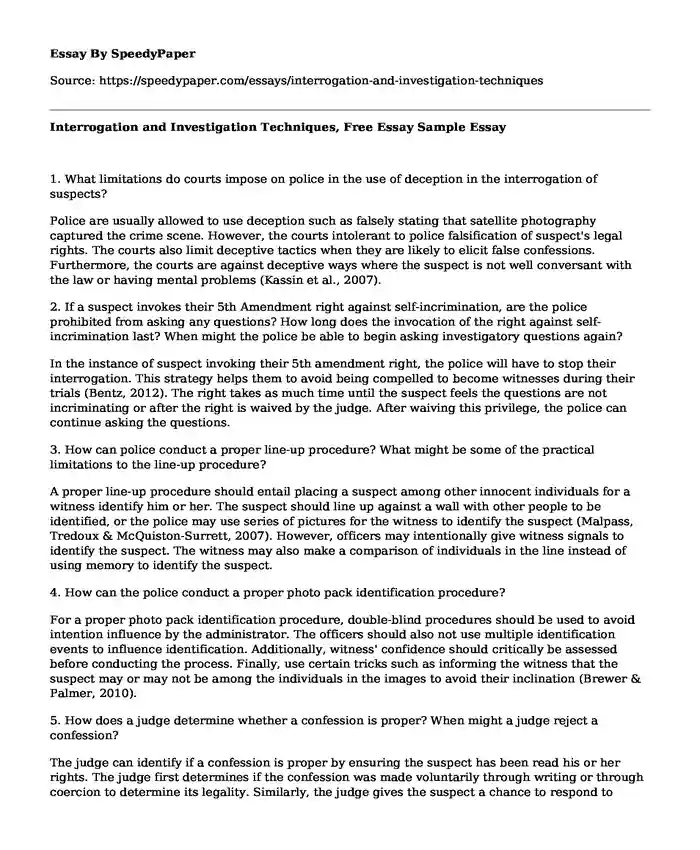
| Type of paper: | Essay |
| Categories: | Criminal law Police |
| Pages: | 3 |
| Wordcount: | 617 words |
1. What limitations do courts impose on police in the use of deception in the interrogation of suspects?
Police are usually allowed to use deception such as falsely stating that satellite photography captured the crime scene. However, the courts intolerant to police falsification of suspect's legal rights. The courts also limit deceptive tactics when they are likely to elicit false confessions. Furthermore, the courts are against deceptive ways where the suspect is not well conversant with the law or having mental problems (Kassin et al., 2007).
2. If a suspect invokes their 5th Amendment right against self-incrimination, are the police prohibited from asking any questions? How long does the invocation of the right against self-incrimination last? When might the police be able to begin asking investigatory questions again?
In the instance of suspect invoking their 5th amendment right, the police will have to stop their interrogation. This strategy helps them to avoid being compelled to become witnesses during their trials (Bentz, 2012). The right takes as much time until the suspect feels the questions are not incriminating or after the right is waived by the judge. After waiving this privilege, the police can continue asking the questions.
3. How can police conduct a proper line-up procedure? What might be some of the practical limitations to the line-up procedure?
A proper line-up procedure should entail placing a suspect among other innocent individuals for a witness identify him or her. The suspect should line up against a wall with other people to be identified, or the police may use series of pictures for the witness to identify the suspect (Malpass, Tredoux & McQuiston-Surrett, 2007). However, officers may intentionally give witness signals to identify the suspect. The witness may also make a comparison of individuals in the line instead of using memory to identify the suspect.
4. How can the police conduct a proper photo pack identification procedure?
For a proper photo pack identification procedure, double-blind procedures should be used to avoid intention influence by the administrator. The officers should also not use multiple identification events to influence identification. Additionally, witness' confidence should critically be assessed before conducting the process. Finally, use certain tricks such as informing the witness that the suspect may or may not be among the individuals in the images to avoid their inclination (Brewer & Palmer, 2010).
5. How does a judge determine whether a confession is proper? When might a judge reject a confession?
The judge can identify if a confession is proper by ensuring the suspect has been read his or her rights. The judge first determines if the confession was made voluntarily through writing or through coercion to determine its legality. Similarly, the judge gives the suspect a chance to respond to confessions to decide whether they were done correctly. Nonetheless, the judge may reject a confession if they find it was done through coercion. If the defendant blatantly denies his or her confessions and posts conviction relief, the judge should dismiss those confessions and give the defendant the right to be heard fairly (Marcus, 2005).
References
Bentz, A. J. (2012). The Original Public Meaning of the Fifth Amendment and Pre-Miranda Silence. Va. L. Rev., 98, 897.
Brewer, N., & Palmer, M. A. (2010). Eyewitness identification tests. Legal and Criminological Psychology, 15(1), 77-96.
Kassin, S. M., Leo, R. A., Meissner, C. A., Richman, K. D., Colwell, L. H., Leach, A. M., & La Fon, D. (2007). Police interviewing and interrogation: A self-report survey of police practices and beliefs. Law and human behavior, 31(4), 381-400.
Malpass, R. S., Tredoux, C. G., & McQuiston-Surrett, D. (2007). Lineup construction and lineup fairness. In The handbook of eyewitness psychology, Vol II: Memory for people (pp. 155-178).
Marcus, P. (2005). It's not just about Miranda: Determining the voluntariness of confessions in criminal prosecutions. Val. UL Rev., 40, 601.
Cite this page
Interrogation and Investigation Techniques, Free Essay Sample. (2022, Mar 11). Retrieved from https://speedypaper.net/essays/interrogation-and-investigation-techniques
Request Removal
If you are the original author of this essay and no longer wish to have it published on the SpeedyPaper website, please click below to request its removal:
- Is Abortion Ever Acceptable? - Essay Sample
- Research Design Methodology Used in Carrying Out the Study of Airbnb. Free Essay.
- Free Essay on Basic History of Recycle-A-Bicycle (RAB)
- Impact of a Comprehensive Workplace Hand Hygiene Program - Article Review Paper Example
- Essay Sample on the Transformation of Human Society: Are We Better Off Now Than Before?
- Essay Sample on Employee's Attitudes
- The Crucial Role of Proteins in Diet - Essay Sample
Popular categories




